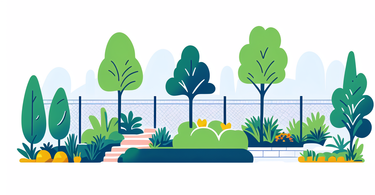Understanding the Aesthetic Appeal of Black Garden Fences
The Contrast of Black and Green in Landscaping
Black garden fences create a striking contrast against lush green foliage. This bold pairing adds depth and drama to any outdoor space. The dark color of the fence makes plants pop, drawing attention to their vibrant hues. It's like creating a living canvas in your backyard. The stark contrast can make your garden feel more organized and intentional. Even simple greenery looks more sophisticated against a black backdrop. This color combo works well in both modern and traditional garden designs. It's a timeless look that never goes out of style.

The Role of Color Theory in Garden Design
Color theory plays a crucial role in creating harmonious garden spaces. Black acts as a neutral anchor, allowing other colors to shine. It provides a sophisticated backdrop for colorful blooms and foliage. In color theory, black enhances other hues, making them appear brighter and more vivid. This effect can make your garden feel more alive and dynamic. Black fences also create a sense of depth, making small spaces appear larger. They can define boundaries without feeling oppressive. When planning your garden, consider how black fences can enhance your overall color scheme.
How Black Fences Complement Flowering Plant Arrangements
Black fences offer a perfect backdrop for flowering plants. They make colorful blooms stand out beautifully. Imagine bright pink roses or purple lavender against a sleek black fence. The contrast is stunning and eye-catching. Black fences also complement white flowers, creating a classic, elegant look. They work well with plants of all colors, from pastels to bold hues. The dark color allows the natural beauty of flowers to take center stage. It's like framing a masterpiece. Black fences can also make green foliage appear lusher and more vibrant. This creates a rich, layered look in your garden.
Installation Tips for Black Garden Fences
Preparing the Ground for Fence Installation
Proper ground preparation is key to a sturdy, long-lasting fence. Start by marking your fence line clearly. Remove any obstacles like rocks or roots. Level the ground as much as possible. This ensures your fence will be even and stable. Dig holes for your fence posts. Make sure they're deep enough - usually about one-third of the post's height. Use a post hole digger or auger for efficiency. Consider the soil type in your area. Clay soil might need wider holes. Sandy soil may require deeper ones. Always check local regulations for fence installation requirements.

Measuring and Marking for Precision
Accurate measurements are crucial for a professional-looking fence. Use a measuring tape to mark out your fence line. Place stakes at corners and intervals along the line. Stretch a string between stakes to ensure a straight line. Double-check all measurements before you start digging. Remember to account for gate openings if needed. Use spray paint or flags to mark post locations. Space posts evenly, typically 6 to 8 feet apart. Always measure twice and cut once to avoid costly mistakes. Take your time with this step - it sets the foundation for your entire fence.
Tips for Installing Black Garden Fences
Installing a black garden fence requires attention to detail. Start by setting your fence posts. Use a level to ensure they're perfectly straight. Mix concrete according to instructions for a strong base. Allow posts to set completely before attaching fence panels. When installing panels, start from one corner and work your way along. Use spacers to maintain consistent gaps between panels. Check for level and plumb as you go. For metal fences, consider using rubber washers to prevent squeaking. Wood fences may need pre-drilling to prevent splitting. Apply a protective coating to maintain the black color and protect against weathering.
Maintaining and Upkeep of Black Garden Fences
Seasonal Maintenance for Longevity
Regular maintenance keeps your black fence looking great year-round. In spring, inspect for winter damage. Clean off any dirt or debris. Check for loose hardware and tighten as needed. Summer is a good time to apply protective coatings. This shields against sun damage and fading. In fall, trim back any overhanging branches. They could damage your fence in winter storms. Before winter, ensure your fence is clean and dry. This prevents moisture damage during freezing temps. Year-round, keep plants from growing too close to the fence. They can cause moisture buildup and damage over time.

Routine Care for Garden Fences
Regular care keeps your black fence in top condition. Clean your fence at least twice a year. Use a mild soap and water solution for general cleaning. For tougher stains, a soft brush can help. Avoid harsh chemicals that might strip the finish. Check for any signs of rust or corrosion on metal fences. Touch up any chips or scratches in the paint promptly. This prevents further damage. Keep an eye out for loose boards or panels. Fix these quickly to maintain the fence's strength. Trim nearby plants regularly to prevent overgrowth. This also allows air to circulate around the fence, preventing mold.
Troubleshooting Common Issues with Garden Fences
Even well-maintained fences can develop issues over time. For wooden fences, watch for signs of rot or insect damage. Replace affected boards promptly. Metal fences might develop rust spots. Sand these down and apply rust-resistant paint. Loose posts can make the whole fence unstable. Reinforce with concrete if needed. Warped boards can often be straightened by adjusting tension. Gates might sag over time. Adjust hinges or add a turnbuckle for support. Fading is common with black fences. Consider repainting or staining every few years. Always address small problems quickly to prevent bigger issues later.
